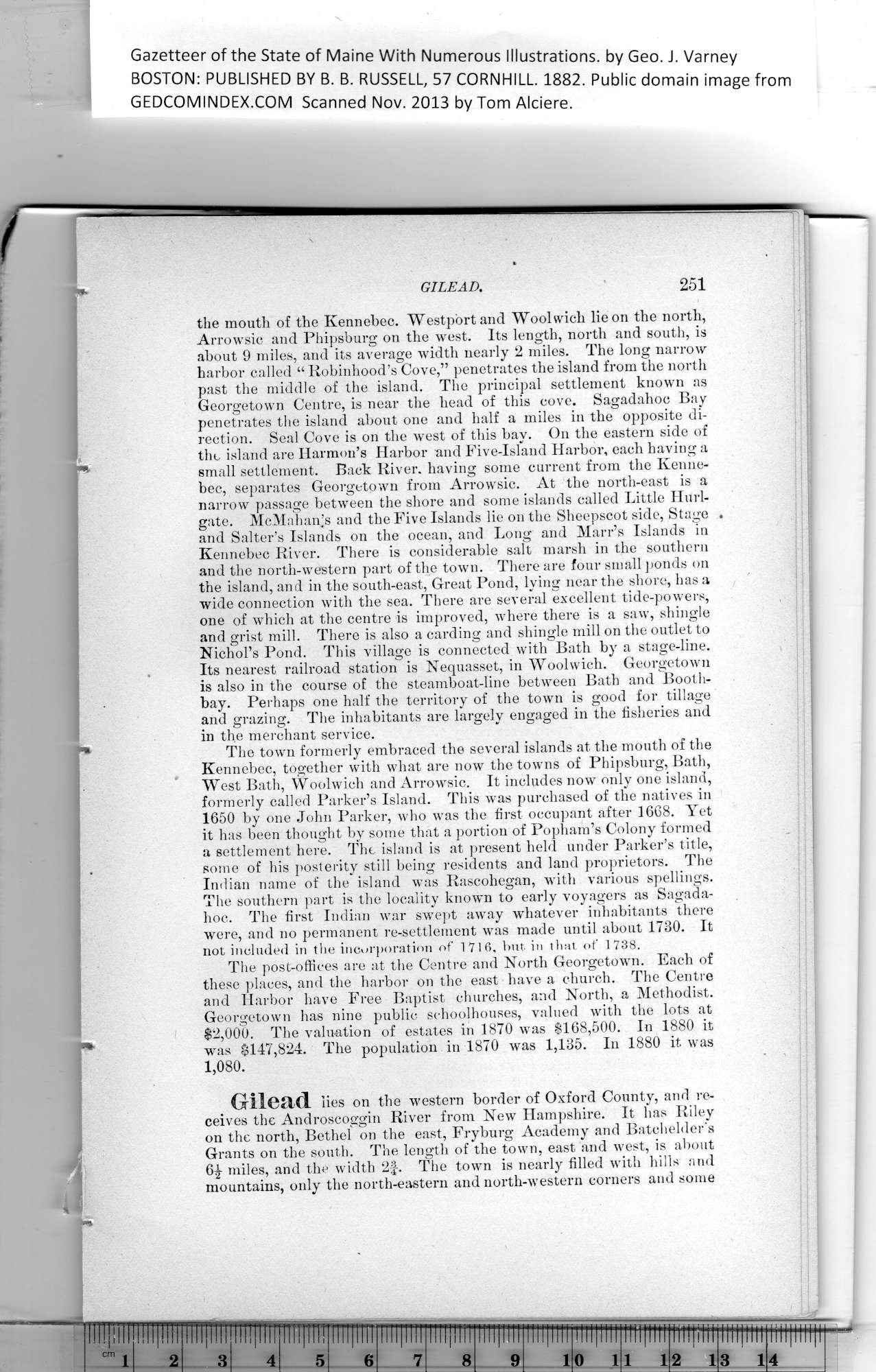|
Gazetteer of the State of Maine With Numerous Illustrations, by Geo. J. Varney
BOSTON: PUBLISHED BY B. B. RUSSELL, 57 CORNHILL. 1882. Public domain image from
GILEAD. 251
the mouth of the Kennebec. Westport and Woolwich lie on the north,
Arrowsic and Phipsburg on the west. Its length, north and south, is
about 9 miles, and its average width nearly 2 miles. The long narrow
harbor called “Robinhood’s Cove,” penetrates the island from the north
past the middle of the island. The principal settlement known as
Georgetown Centre, is near the head of this cove. Sagadahoc Bay
penetrates the island ahout one and half a miles in the opposite di-
rection. Seal Cove is on the west of this bay. On the eastern side of
the island are Harmon’s Harbor and Five-Island Harbor, each having a
small settlement. Back River, having some current from the Kenne-
bec, separates Georgetown from Arrowsic. At the north-east is a
narrow passage between the shore and some islands called Little Hurl-
gate. McMahan.’s and the Five Islands lie on the Sheepscot side, Stage .
and Salter’s Islands on the ocean, and Long and Marr’s Islands in
Kennebec River. There is considerable salt marsh in the southern
and the north-western part of the town. There are four small ponds on
the island, and in the south-east, Great Pond, lying near the shore, has a
wide connection with the sea. There are several excellent tide-powers,
one of which at the centre is improved, where there is a saw, shingle
and grist mill. There is also a carding and shingle mill on the outlet to
Nichol’s Pond. This village is connected with Bath by a stage-line.
Its nearest railroad station is Nequasset, in Woolwich. Georgetown
is also in the course of the steamboat-line between Bath and Booth-
bay. Perhaps one half the territory of the town is good for tillage
and grazing. The inhabitants are largely engaged in the fisheries and
in the merchant service.
The town formerly embraced the several islands at the mouth of the
Kennebec, together with what are now the towns of Phipsburg, Bath,
West Bath, Woolwich and Arrowsic. It includes now only one island,
formerly called Parker’s Island. This was purchased of the natives in
1650 by one John Parker, who was the first occupant after 1668. Yet
it has been thought by some that a portion of Popham’s Colony formed
a settlement here. The island is at present held under Parker’s title,
some of his posterity still being residents and land proprietors. The
In dian name of the island was Rascohegan, with various spellings.
The southern part is the locality known to early voyagers as Sagada-
hoc. The first Indian war swept away whatever inhabitants there
were, and no permanent re-settlement was made until about 1730. It
not included in the incorporation of 1716, but in that of 1738.
The post-offices are at the Centre and North Georgetown. Each of
these places, and the harbor on the east have a church. The Centre
and Harbor have Free Baptist churches, and North, a Methodist.
Georgetown has nine public schoolhouses, valued with the lots at
$2,000. The valuation of estates in 1870 was $168,500. In 1880 it
was $147,824. The population in 1870 was 1,135. In 1880 it was
1,080.
Gilead lies on the western border of Oxford County, and re-
ceives the Androscoggin River from New Hampshire. It has Riley
on the north, Bethel on the east, Fryburg Academy and Batchelder's
Grants on the south. The length of the town, east and west, is about
6^- miles, and the width 2f. The town is nearly filled with hills and
mountains, only the north-eastern and north-western corners and some
PREVIOUS PAGE ... NEXT PAGE
This page was written in HTML using a program written in Python 3.2
|
